Intel Atom Z6 chips focus on smartphone/tablet power and efficiency

Yesterday Intel announced its Atom Z6 processors aimed at smartphones and tablets.
The new chips, previously known by the code name of "Lincroft" which forms part of the "Moorestown" platform, are Intel's answer to the growing need for more power on mobile devices, but without sacrificing battery life. The Atom Z6 uses a "system-on-a-chip" design that incorporates the processor, audio, video and graphics.

On the graphics front, the Atom Z6 features integrated Intel GMA 600 Graphics that's been optimized for mobile usage. The integrated GPU runs as 400MHz and supports OpenGL ES2.0 and 2.1, and Open VG 1.1. Also featured is hardware-accelerated HD video encoding (MPEG-4 part 2, H.264) and decoding (MPEG-4 part 2, H.264, WMV, and VC1). Maximum display resolution is 1,366 x 768 LVDSor 1,024 x 600 MIPI.
In a somewhat vague statement, Intel said that standby time using a "Blackberry-style" battery would be 10 days, while Web browsing or watching video would see the battery last for about five hours. This, according to Intel, is comparable with high-end "premium" smartphones.
Battery life is the new MHz/GHz, especially when it comes to mobile devices. While users still need power, they're increasingly interested in how long they can go before hooking up their mobile device to a charger cord. Not only that, but users want to be able to do more things on the move, such as watch videos and play games. These activities put a huge demand on the battery, and without improved efficiency at the core CPU/graphics level, busy smartphone users are going to find their portable device spending more and more time tethered to the power supply.
Web performance has improved dramatically. JavaScript-rich sites previously taking eight to ten seconds to load are now done in about two seconds. That's seriously fast, and means people will get more done in less time. After all, most people spend more time browsing the web on their smartphones than they do talking.
While the Atom Z6 is certainly a performance boost, and there's no doubt that Intel has worked hard on efficiency, this hasn't translated into a significant boost in battery life that the user will notice. Do more, or work longer. You can have one, but not both.